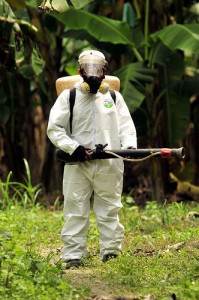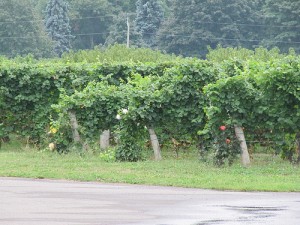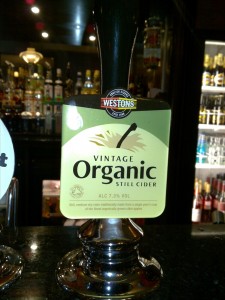The use of commercial fungicides is commonplace in conventionally managed vineyards, often utilizing sulfur or synthetically produced formulations. With the use of these fungicides there comes an associated health risk, both to the environment and to those animals or people that consume the fruit produced from a treated grapevine. As a result of the increased concern over the health of the environment, particularly in this age of changing climate, there is an increased desire and pressure to move to a more organically managed style of

Photo by CIAT International Center for Tropical Agriculture: http://farm5.staticflickr.com/4140/4875332597_48221ef963.jpg
viticulture, including distancing from the conventional chemical fungicide approach to more environmentally-friendly bio-based alternatives.
One bio-based alternative in particular, chitosan, has been considered to be a potential more natural alternative to sulfur-based conventional fungicides and has been shown to be effective in other plant models. Chitosan is present on the cell walls of many types of fungi and chitosan receptors are known to be present in the cells of many plant species. If chitosan comes into contact with the chitosan receptors on the plant, the plants own natural defenses are activated, resulting in the natural protection of the plant against the foreign attacker.
In addition to the plant’s own natural defensive pathways ability to protect against an attack elicited by chitosan activation, it has been shown that chitosan treatments do not reduce crop yield in many plant species, suggesting that plant metabolism is not compromised by this type of treatment.
Powdery mildew (Erysiphe necator Schwein or Uncinula necator Schwein) is a common disease in grapevines that affect grape yield and quality. Briefly, what happens is that mildew spores overwintering in the dead plant litter are released in the spring and infect the new grapevine host. Secondary infections occur later and infect the skin layer of the leaves and fruit. Ultimately, this infection leads to overall decreases in berry yield and berry quality, which subsequently leads to decreased wine quality.
Controlling powdery mildew in plants is typically managed by conventional chemical fungicides, though more organic approaches are being implemented every year. Using chitosan to induce natural plant defenses has been shown to not only defend against plant pathogens, but also increase certain polyphenolic compounds in the plant. This treatment results in the increased quality and antioxidant capacity of the foods created or produced from chitosan-treated plants.
The study presented today, which was published in 2011 and therefore may not be new for some of you, aimed to test the effectiveness of a new chitosan-based formulation on the grapevine against powdery mildew infection, as well as the analysis of the total polyphenol content of the grapes and resulting wine.
Methods
Kendal Cops (KC) was the chitosan-based formulation used in this study, and was based on a 4% solution of chitosan with 1.5% Cu2+ and 0.5% Mn2+. Different dilutions of KC were tested, as well as mixtures of KC and conventional fungicides, and conventional fungicides alone. Conventional fungicides used in the experiment were penconazole and methyldinocap.
Experiments were performed at an experimental vineyard in Chieti, Italy, the grapevines of which were planted in 1999. The experimental vineyard was located in a place that is predisposed to severe powdery mildew infections (Piazzano d’Atessa). Grapevines planted were the Montepulciano d’Abruzzo cultivar.
Negative controls were left as untreated vines, and positive controls were those treated only with chemical fungicides. The experiment was set up as a complete randomized block design with 4 replicates and 10 vines per block.
Plants were sprayed every 7 days using a spray lance to avoid spray drift, from the beginning of the susceptibility of the grapes to powdery mildew infection to the end of the veraison period (i.e. once the grapes completely changed colors).
Powdery mildew infection symptoms were monitored weekly on the leaves and grape clusters by visual inspection. Disease incidence (i.e. percentage of infected leaves or clusters) and disease severity (on a scale of 0-5) were measured. Using these data, percentage of infection was calculated.
Experimental wines were produced using standard enological methods at the Viticultural Research Center of Conegliano.
Total phenolic content and antiradical/antioxidant activity were analyzed on grape clusters (isolating the skins, flesh, and seeds) as well as the experimental wines.
Results
- In untreated controls, powdery mildew incidence was 98% in the leaves and 100% in the grape clusters.
- All plants containing KC (chitosan-based formulation) were effectively controlled against powdery mildew without causing any phytotoxicity to the plant or the grapes.
- The KC formulation with the highest concentration (10mL/L) was most effective against powdery mildew, with comparable protection levels compared to the fungicide control.
- For example, on August 1st, disease severity was 87.5% in untreated control, whereas disease severity was only 2.39% in the more highly concentrated chitosan-based formulation (KC)and 0.92% in the fungicide-treated plants.
- KC (high dose) and fungicide disease severity levels were not significantly different from one another.
- All other doses of KC as well as combinations of KC and fungicides were not significantly different than the fungicide control, but were significantly more effective than the untreated control.
- For example, on August 1st, disease severity was 87.5% in untreated control, whereas disease severity was only 2.39% in the more highly concentrated chitosan-based formulation (KC)and 0.92% in the fungicide-treated plants.
- The highest polyphenol content was found in the skin, then the seeds, and then finally the grape flesh.
- For grapevines treated with KC (chitosan), polyphenol levels in grape skins increased by 19% and levels in the grape seed since increased by 22.5%, compared to the control skins (not treated).
- For grapevines treated with conventional fungicides, polyphenol levels in grape skins decreased by 19% in the skins and decreased by 10% in the seeds compared with the untreated control.
- For wines, those made from grapes that were treated with KC (chitosan) had significantly higher levels of polyphenols than conventional wines (increase of 7%).
- The highest concentration of polyphenols was found in the untreated control wine.
- Antiradical activity was lowest for plants treated with KC.
- There was a negative correlation between antiradical activity and polyphenol levels in the experimental wines.
What does this all mean?
In summary, the results of this study showed that the organic chitosan-based formulation KC was just as effective against powdery mildew at a concentration of 10mL/L as the conventional fungicide,without eliciting any negative phytotoxicity side effects. Also, treatment with KC resulted in an overall
increase in polyphenols in the grape skins, seeds, and pulp, which is indicative of higher quality grapes and subsequently higher quality wines.
Even though the authors do describe some of the other work on with other alternatives to conventional fungicides, I would have liked instead for them to compare these other alternatives directly against KC, to determine if one was more effective than the other. Based on some of the comments made by the authors of inefficiency and phytotoxicity in some of these other alternative formulations, KC may be the most efficient and least harmful for the environment as a whole.
I would also be curious to have seen a sensory analysis performed on these experimental wines. Yes, the polyphenol content changed in wines treated with KC versus wines not treated with KC (or treated with conventional fungicides), but how do these wines differ in regards to their sensory characteristics? Are they better? Worse? Depends?
Exactly which polyphenols saw concentration changes? This study only looked at total polyphenols, but it would be interesting to see how individual polyphenols changed with this alternative fungicide treatment. Do only certain polyphenols increase in concentration? Or is it all polyphenols increasing all together?
Is this chitosan formulation effective against powdery mildew in all grape cultivars? How about in different growing regions?
Overall, I think this is a very interesting study that provides a promising alternative to conventional fungicides that is very efficient at combating against powdery mildew infection, kind to the environment, and also potentially resulting in products that may be even better for you that if the grapes were not treated at all. Using chitosan-based formulations employ the pathways of the plants’ own natural defenses, thus resulting in a truly organic and extremely effective tool for managing powdery mildew infections in the grapevine.
I’d love to hear your thoughts on this topic. Please feel free to start a discussion!
Source: Iriti, M., Vitalini, S., Di Tommaso, G., D’Amico, S., Borgo, M., and Faoro, F. 2011. New chitosan formulation prevents grapevine powdery mildew infection and improves polyphenol content and free radical scavenging activity of grape and wine. Australian Journal of Grape and Wine Research 17: 263-269.



4 comments for “Using A Plants’ Own Natural Defenses to Protect Against Powdery Mildew and Increase Polyphenol Levels in Grapes and Wine”